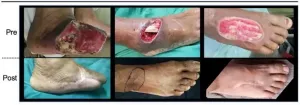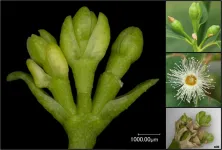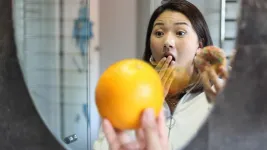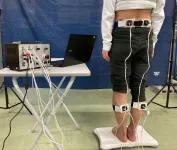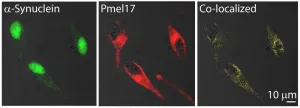How the spinifex got its hole
Researchers have long been curious about the striking growth form of spinifex and now UNSW Sydney scientists say soil microbes are the answer
2021-04-07
(Press-News.org) Anyone who has visited the Australian outback would be familiar with spinifex grasses, which cover almost a fifth of our continent.
Like many scientists, they may have also wondered why this iconic arid grass grows in striking ring shapes.
Previous studies have tested whether spinifex rings could be caused by termites, water availability or nutrient depletion, but none has provided a convincing explanation.
Now scientists from UNSW Sydney have found that pathogenic soil microbes play a role in how the spinifex got its hole.
Their study, the first of its kind in an arid ecosystem, has been published in the Australian Journal of Botany.
Professor Angela Moles and Neil Ross from The Evolution & Ecology Research Centre tested the idea that an accumulation of pathogenic soil microbes might impede seedling emergence and subsequent growth in the centre of spinifex rings.
They collected soil from inside and outside naturally occurring spinifex rings and compared plants grown in soil with live microbes to plants grown in sterilised soil.
"Consistent with our hypothesis, we found that sterilising soil from the inside of spinifex rings significantly increased spinifex seedling emergence," Prof. Moles said.
"We also found that seedings had significantly higher seedling emergence in unsterilised soil from outside the rings than in unsterilised soil from inside the rings."
Their results suggest that die-back in the centre of spinifex plants might be explained by older parts of the plant succumbing to a build-up of pathogenic soil microbes through time, where as new seedlings tend to establish more at the outside edge of the rings where there are fewer
pathogens in the soil.
"Most people tend to think of the beneficial effects of microbes on plant growth," co-author and director of UNSW Science's Evolution & Ecology Research Centre, Professor Angela Moles said.
"However, sterilising soil actually makes most plants grow better. That is, the negative effects of the pathogenic microbes tend to outweigh the positive effects of the beneficial microbes."
"Overall, these results suggest that soil pathogens are quietly shaping the way the plants around us grow."
Prof. Moles said this new information helps scientists further understand the unique ecology of Australia's arid grasslands, and adds to the growing recognition of the crucial function that soil microbes play in terrestrial ecosystem processes worldwide.
The scientists have recommended further study to identify the types of soil microbes involved in the establishment of arid-zone plants, as well as the different types of microbes that are most important for seedlings at different times or under different germination conditions.
INFORMATION:
Read the study in Australian Journal of Botany.
MEDIA CONTACT: Diane Nazaroff, diane.nazaroff@unsw.edu.au, 0424 479 199.
ELSE PRESS RELEASES FROM THIS DATE:
2021-04-07
Durham, NC - According to the results of a phase 1 clinical trial just published in STEM CELLS Translational Medicine, a new stem cell therapy shows promise of making diabetes-related amputations a thing of the past. The trial involved injecting diabetes patients suffering from non-healing diabetic foot ulcers (DFU) with a cell preparation containing adult stem cells harvested from their own fat. The results showed that the treatment induced regeneration of the blood vessels surrounding the DFUs, accelerated healing - all with no serious side effects.
"Non-healing diabetic foot ulcers usually ...
2021-04-07
CORVALLIS, Ore. - Eucalyptus, a pest-resistant evergreen valued for its hardy lumber and wellness-promoting oil, can be genetically modified not to reproduce sexually, a key step toward preventing the global tree plantation staple from invading native ecosystems.
Oregon State University's Steve Strauss led an international collaboration that showed the CRISPR Cas9 gene editing technique could be used with nearly 100% efficiency to knock out LEAFY, the master gene behind flower formation.
"The flowers never developed to the point where ovules, pollen or ...
2021-04-07
Two thirds of New Zealanders believed there were 'silver linings' to the country's Alert Level 4 COVID-19 lockdown imposed in March last year, a University of Otago survey has found.
The researchers were able to question New Zealanders while they were at home, giving a unique insight into their lives during the nationwide lockdown between 25 March and 23 April, widely regarded as one of the strictest imposed anywhere in the world.
One year on from lockdown, the results of their study have been published in the international scientific journal, PLOS ONE.
Participants were asked 'Have you experienced any silver linings, or positive aspects during the COVID-19 Level 4 lockdown' and were able to answer 'yes, for me personally', ...
2021-04-07
Can a mirror turn an orange into a doughnut? The answer is definitely no in the real (macro) world. But at the nanoscale, a mirror can turn an "orange" shaped pattern into a "doughnut" shaped pattern by overlapping the "orange" with its reflected mirror image.
A team of researchers from the University of Technology Sydney (UTS) has shown for the first time that fluorescent nanoparticles placed near a mirror generate unique patterns that can be used to pinpoint their location.
The researchers attribute this effect to the light emitting nanoparticle's interference with its own mirror image. Using this method they can also detect the size of particles to a resolution of one nanometre - or around 1/80,000th of the diameter of a human ...
2021-04-07
Areas with a relatively greater amount of misogynistic tweets have higher incidences of domestic and family violence, a UNSW study has found.
The study, published in Psychological Science, not only found this connection with domestic and family violence carried over from one year to the next, but also occurred despite the 'usual suspects' of domestic violence, such as alcohol and inequality.
Examples of misogynistic tweets identified by the researchers included, "Women are all bitches," "Whore had it coming," and, "Make me a sandwich, slut."
"We found that misogynistic ...
2021-04-07
Ever since the early humans learned to walk upright, they have suffered, as an unfortunate consequence of their erect posture, from low back pain. Modern understanding on this matter dictates that low back pain, in particular, is caused due to a postural instability resulting from poor "proprioception", which is a term for the perception of part of our body's own position in space. In fact, our trunk and lower legs are key to maintaining postural stability due to the presence of "proprioceptors"--sensory receptors responding to position and movement--in those areas.
Elderly people suffering from low back pain tend to have poorly performing proprioceptors, ...
2021-04-07
COLUMBUS, Ohio - Researchers have found a way to use chaos to help develop digital fingerprints for electronic devices that may be unique enough to foil even the most sophisticated hackers.
Just how unique are these fingerprints? The researchers believe it would take longer than the lifetime of the universe to test for every possible combination available.
"In our system, chaos is very, very good," said Daniel Gauthier, senior author of the study and professor of physics at The Ohio State University.
The study was recently published online in the journal IEEE Access.
The researchers created a new version ...
2021-04-07
(Boston)--Diagnosing Chronic Traumatic Encephalopathy (CTE) during life is crucial for developing therapies and for determining how common the disease is among individuals exposed to repetitive head impacts from contact sports, military service and physical violence.
While the ability to diagnose CTE prior to death has remained elusive, researchers from Boston University School of Medicine (BUSM) for the first time have shown that progressive memory loss and issues with executive function, the ability to focus, follow directions, and problem-solve, are more useful for predicting CTE pathology than mood and behavior symptoms.
CTE is a progressive brain disease. Clinically, impulsivity, explosivity, depression, memory impairment and executive dysfunction have been reported to ...
2021-04-07
WASHINGTON, April 7, 2021 -- On the surface, Parkinson's disease -- a neurodegenerative disorder -- and melanoma -- a type of skin cancer -- do not appear to have much in common. However, for nearly 50 years, doctors have recognized that Parkinson's disease patients are more likely to develop melanoma than the general population. Now, scientists report a molecular link between the two diseases in the form of protein aggregates known as amyloids.
The researchers will present their results today at the spring meeting of the American Chemical Society (ACS). ACS Spring 2021 is being held online April 5-30. Live sessions will be hosted April ...
2021-04-07
DALLAS, April 7, 2021 — Receiving palliative or hospice care services was found to improve quality of life for hospitalized ischemic stroke patients, however, disparities persist in which patients are prescribed or have access to these holistic comfort care options, according to new research published today in the Journal of the American Heart Association, an open access journal of the American Heart Association.
Prior to the COVID-19 pandemic, stroke ranked No. 5 among all causes of death in the U.S. Nearly 9 in 10 strokes are ischemic strokes caused by a blockage in a blood vessel that carries blood to the brain. Despite advances in acute stroke treatment and management, stroke remains a leading cause of serious long-term disability in the U.S.
“Stroke ...
LAST 30 PRESS RELEASES:
[Press-News.org] How the spinifex got its hole
Researchers have long been curious about the striking growth form of spinifex and now UNSW Sydney scientists say soil microbes are the answer
